文章目录
导读
数据从数据集路径读取到数据迭代器Dataset后再送入加载器DataLoader,然后通过for in 激活DataLoader,使DataLoader在内部按批分配索引,通过索引采样-index=self._next_index()函数划分索引列表,通过数据采样-data = self._dataset_fetcher.fetch(index)函数下发索引给Dataset,使得 def getitem(self, index):根据索引处理后返给DataLoader加载器,按批将索引全部下发并且返回该批的所有数据后,就可以进一步进行模型的训练。
YoloDataset类需要传入的参数解读
class YoloDataset(Dataset):
def __init__(self, annotation_lines, input_shape, num_classes, anchors, anchors_mask, epoch_length, \
mosaic, mixup, mosaic_prob, mixup_prob, train, special_aug_ratio = 0.7):
super(YoloDataset, self).__init__()
self.annotation_lines = annotation_lines
self.input_shape = input_shape
self.num_classes = num_classes
self.anchors = anchors
self.anchors_mask = anchors_mask
self.epoch_length = epoch_length
self.mosaic = mosaic
self.mosaic_prob = mosaic_prob
self.mixup = mixup
self.mixup_prob = mixup_prob
self.train = train
self.special_aug_ratio = special_aug_ratio
self.epoch_now = -1
self.length = len(self.annotation_lines)
self.bbox_attrs = 5 + num_classes
def __len__(self):
return self.length
其中:
-
self.annotation_lines是训练集数据对应的txt文件内容,格式为 [图片绝对路径,图片所有真实框]。如图所示
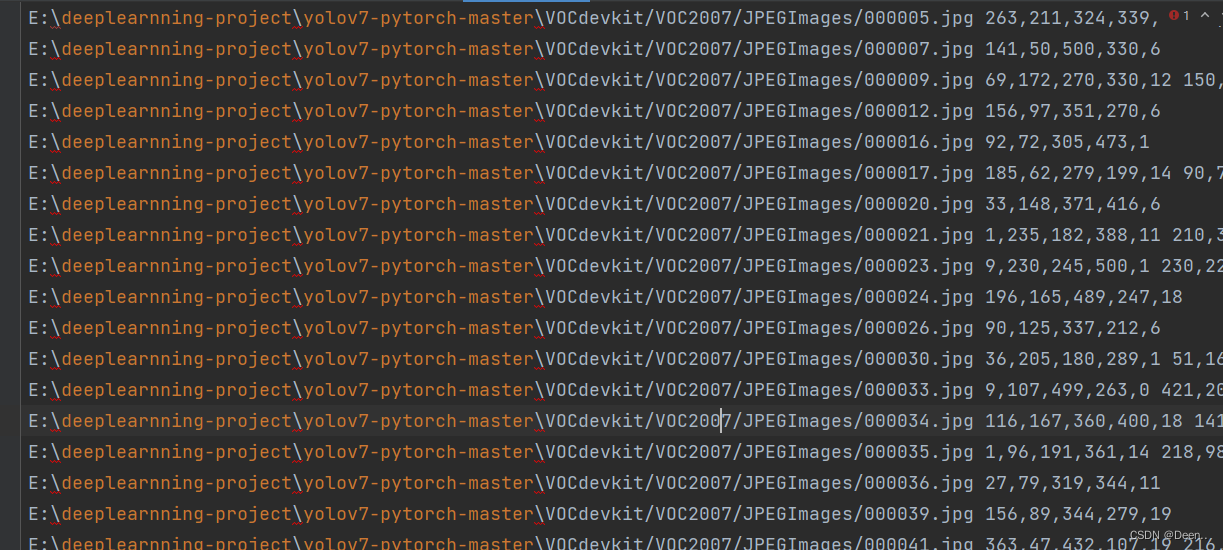
-
input_shape 为设定输入模型的固定尺寸,该例设为 [300,300]
-
self.num_classes 类别数量
-
self.anchors 锚框的尺寸,这里有9个锚框

- self.epoch_length 训练总轮次
- self.mosaic 是否用mosaic技术
- self.mosaic_prob 每个step有多少概率使用mosaic数据增强,默认50%。
- self.mixup 是否用mixup技术
- self.mixup_prob 有多少概率在mosaic后使用mixup数据增强,默认50%。
- self.train 判断是否为训练阶段,非训练阶段处理与训练处理存在差异
- self.special_aug_ratio 本代码会在special_aug_ratio范围内开启mosaic。 默认为前70%个epoch,100个epoch,前70个开启mosaic。
- self.epoch_now 用来定位单前是第几个epoch。
- self.length 数据集数量
- self.bbox_attrs 输出的属性长度 5 + num_classes
根据索引开始处理单张图片-getitem()
DataLoader通过fetch()去调用YoloDataset(Dataset)中的__getitem__():

通过getitem()根据fetch下发的索引(inx)往外一张一张蹦图。
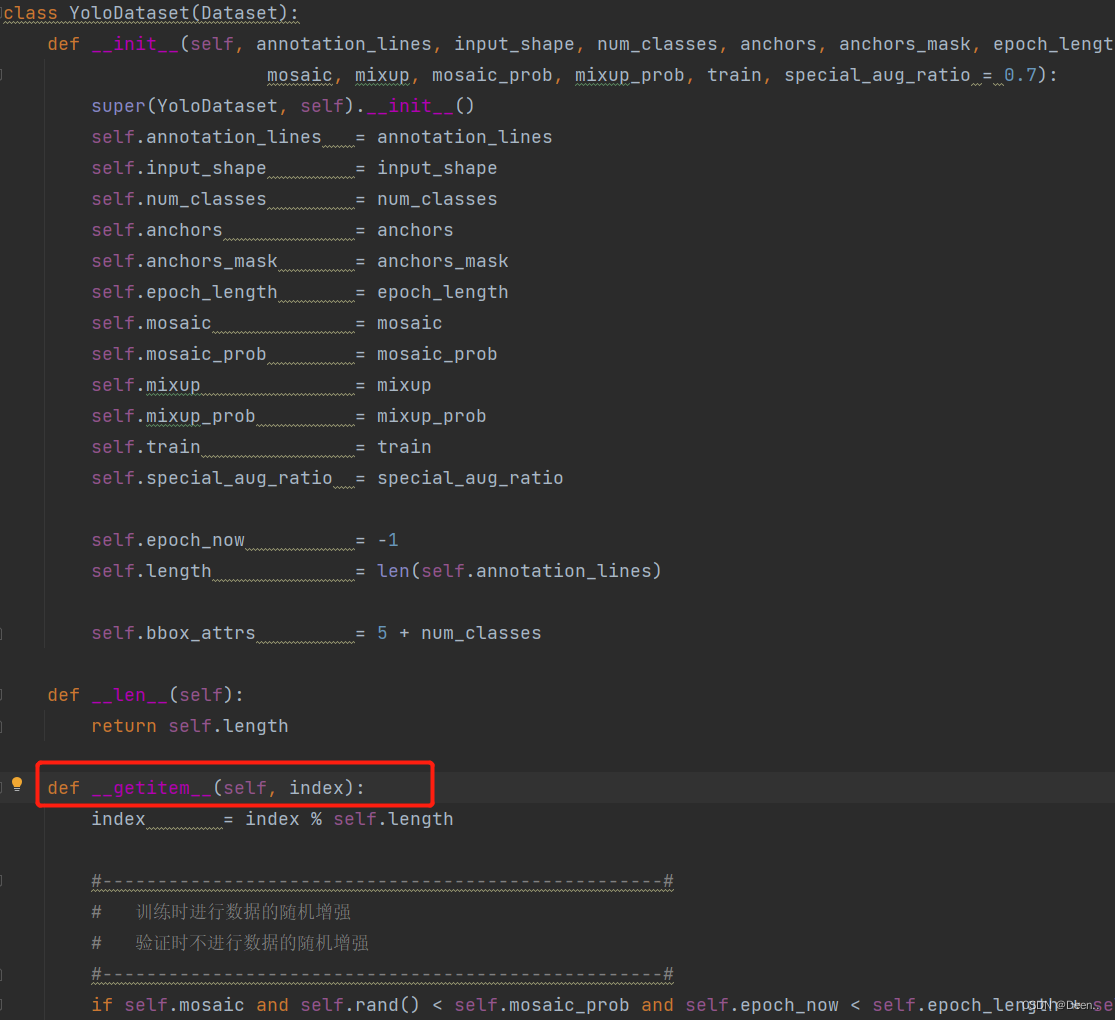
下发的index,先判断是否超出总长度
index = index % self.length
然后通过self.get_random_data()将索引的图片地址跟真实框信息读取进来进行处理。
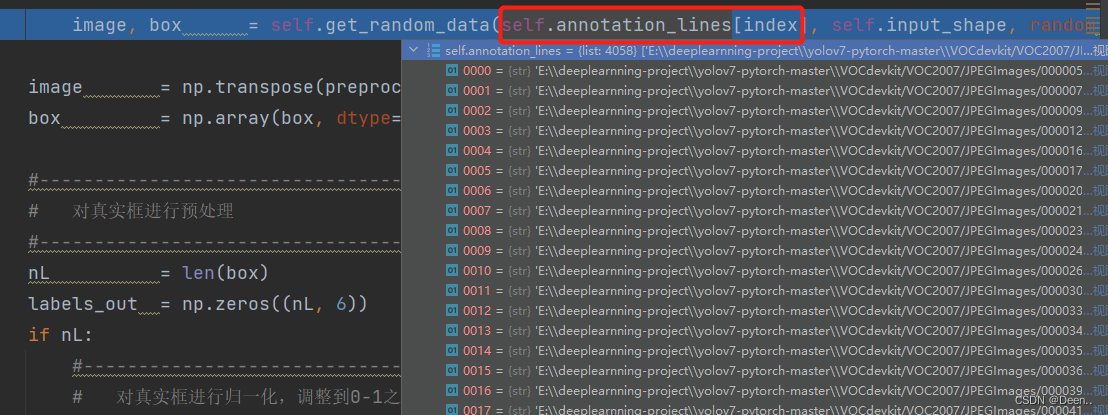
image, box = self.get_random_data(self.annotation_lines[index], self.input_shape, random = self.train)
读取完的数据如图所示:

1.数据初步处理-get_random_data()
传进该函数的annotation_line如图所示,包含了图片的地址跟真实框信息:

将图片地址加载进来获取图片,然后将图片转RGB格式,如果原来就是RGB就返回,不是的话就转RGB。然后将获取图片真实宽和高,再获取真实框。
def get_random_data(self, annotation_line, input_shape, jitter=.3, hue=.1, sat=0.7, val=0.4, random=True):
line = annotation_line.split()
#------------------------------#
# 读取图像并转换成RGB图像
#------------------------------#
image = Image.open(line[0])
image = cvtColor(image)
#------------------------------#
# 获得图像的高宽与目标高宽
#------------------------------#
iw, ih = image.size
h, w = input_shape
#------------------------------#
# 获得真实框
#------------------------------#
box = np.array([np.array(list(map(int,box.split(',')))) for box in line[1:]])
判断是不是训练模式,random=True时,是训练模式,下图是非训练模式,我们留一会再说,先看训练模式下,怎么处理数据。

- 图片预处理
获取完图片后,判断是训练模式还是验证模式,如果是训练模式就对图像先进行预处理
图片缩放
new_ar = iw/ih * self.rand(1-jitter,1+jitter) / self.rand(1-jitter,1+jitter)
scale = self.rand(.25, 2)
if new_ar < 1:
nh = int(scale*h)
nw = int(nh*new_ar)
else:
nw = int(scale*w)
nh = int(nw/new_ar)
image = image.resize((nw,nh), Image.BICUBIC)
将图片多余部分设置成灰条
dx = int(self.rand(0, w-nw))
dy = int(self.rand(0, h-nh))
new_image = Image.new('RGB', (w,h), (128,128,128))
new_image.paste(image, (dx, dy))
image = new_image
翻转图片
flip = self.rand()<.5
if flip: image = image.transpose(Image.FLIP_LEFT_RIGHT)
image_data = np.array(image, np.uint8)
色域变换 这里用的是HSV变换
r = np.random.uniform(-1, 1, 3) * [hue, sat, val] + 1
hue, sat, val = cv2.split(cv2.cvtColor(image_data, cv2.COLOR_RGB2HSV))
dtype = image_data.dtype
x = np.arange(0, 256, dtype=r.dtype)
lut_hue = ((x * r[0]) % 180).astype(dtype)
lut_sat = np.clip(x * r[1], 0, 255).astype(dtype)
lut_val = np.clip(x * r[2], 0, 255).astype(dtype)
image_data = cv2.merge((cv2.LUT(hue, lut_hue), cv2.LUT(sat, lut_sat), cv2.LUT(val, lut_val)))
image_data = cv2.cvtColor(image_data, cv2.COLOR_HSV2RGB)
以上就完成了对图像的预处理,非训练的验证模式没有图片预处理部分,它只做真实框调整。
- 真实框按比例调整
真实框格式如下图所示,真实框的内容是左上角右下角坐标,将真实框送入模型进行预测,需要将真实框转换为相对锚框的偏移量,然后预测处理的预测框也是相对锚框偏移量的格式来表示。转换成[x,y,w,h]格式,中心坐标为(x,y),w为框的宽度,h为高度。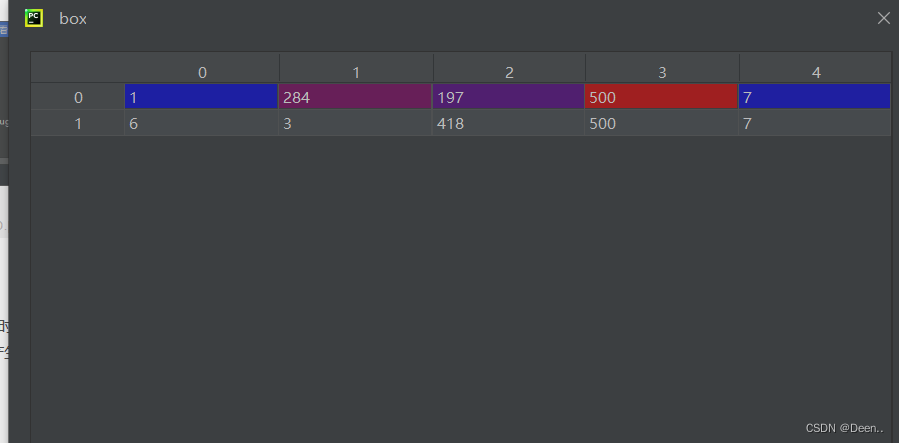
- 因为将图片从原来本身的尺寸压缩到要输入图片的尺寸时,按比例压缩,当真实图片的尺寸跟输入模型图片的尺寸不等比例时,就产生灰边。下列代码将获取图片按输入模型尺寸缩放后的尺寸。
if len(box)>0:
np.random.shuffle(box)
box[:, [0,2]] = box[:, [0,2]]*nw/iw + dx
box[:, [1,3]] = box[:, [1,3]]*nh/ih + dy
if flip: box[:, [0,2]] = w - box[:, [2,0]]
box[:, 0:2][box[:, 0:2]<0] = 0
box[:, 2][box[:, 2]>w] = w
box[:, 3][box[:, 3]>h] = h
box_w = box[:, 2] - box[:, 0]
box_h = box[:, 3] - box[:, 1]
box = box[np.logical_and(box_w>1, box_h>1)]
return image_data, box
调整完后,将图片跟真实框返给image, box 。

如果是验证模式,就不进行图像预处理,直接调整真实框。
将数据转为numpy格式的32位浮点数:
image = np.transpose(preprocess_input(np.array(image, dtype=np.float32)), (2, 0, 1))
box = np.array(box, dtype=np.float32)
Mosaic
通过self.mosaic、self.mosaic_prob、self.epoch_now、self.special_aug_ratio、self.mixup 、self.mixup_prob来控制是否要对图像进行Mosaic处理,具体为:
self.rand()随机生成一个0-1的数,如果这个数小于self.mosaic_prob的值,也就是百分50的概率打开Mosaci,且在训练的前70%epoch才能打开Mosaci,在同时满足这些的条件下,进行Mosaic训练,Mixup是在Mosiac的基础上,有50%的概率取用。
如代码所示:
if self.mosaic and self.rand() < self.mosaic_prob and self.epoch_now < self.epoch_length * self.special_aug_ratio:
lines = sample(self.annotation_lines, 3)
lines.append(self.annotation_lines[index])
shuffle(lines)
image, box = self.get_random_data_with_Mosaic(lines, self.input_shape)
if self.mixup and self.rand() < self.mixup_prob:
lines = sample(self.annotation_lines, 1)
image_2, box_2 = self.get_random_data(lines[0], self.input_shape, random = self.train)
image, box = self.get_random_data_with_MixUp(image, box, image_2, box_2)
Mosaic具体为,先对数据集进行随机抽样3张图,然后跟要处理的图混在一起打乱。再取一张图片,对其进行以下处理:
- 翻转,翻转的概率为50%
flip = self.rand()<.5
if flip and len(box)>0:
image = image.transpose(Image.FLIP_LEFT_RIGHT)
box[:, [0,2]] = iw - box[:, [2,0]]
- 对图像进行缩放并且进行长和宽的扭曲,这个缩放的大小的是随机的
new_ar = iw/ih * self.rand(1-jitter,1+jitter) / self.rand(1-jitter,1+jitter)
scale = self.rand(.4, 1)
if new_ar < 1:
nh = int(scale*h)
nw = int(nh*new_ar)
else:
nw = int(scale*w)
nh = int(nw/new_ar)
image = image.resize((nw, nh), Image.BICUBIC)
- 将图片进行放置,分别对应四张分割图片的位置
if index == 0:
dx = int(w*min_offset_x) - nw
dy = int(h*min_offset_y) - nh
elif index == 1:
dx = int(w*min_offset_x) - nw
dy = int(h*min_offset_y)
elif index == 2:
dx = int(w*min_offset_x)
dy = int(h*min_offset_y)
elif index == 3:
dx = int(w*min_offset_x)
dy = int(h*min_offset_y) - nh
new_image = Image.new('RGB', (w,h), (128,128,128))
new_image.paste(image, (dx, dy))
image_data = np.array(new_image)
假设四张图的随机缩放大小都一样,且x,y的偏置都一样,如下图所示,四张图拼成一张,划斜线的部分为最后展示的内容,重叠的部分重叠展示。
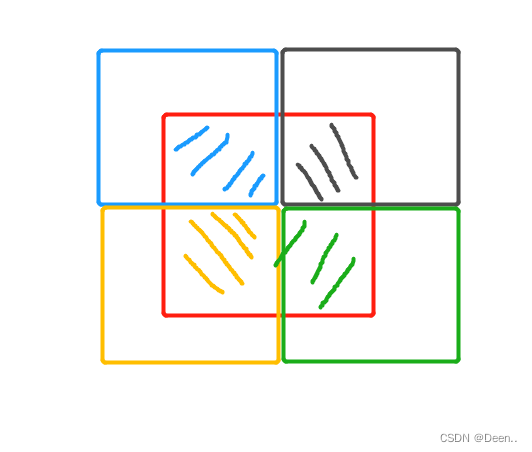
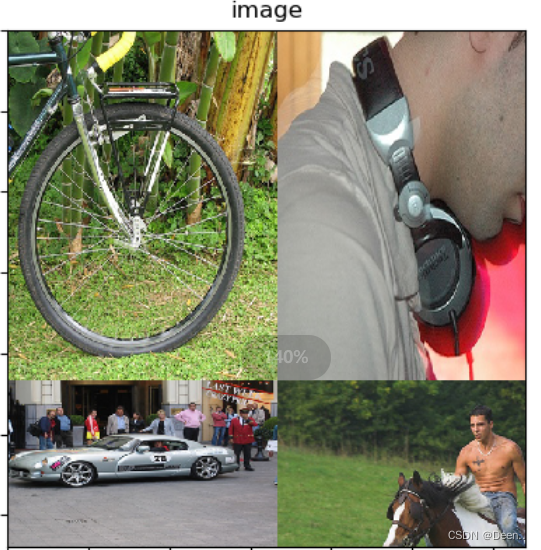
- 图片处理好后,对真实框做处理,具体为按着x,y的偏置,以及图像的缩放比例,将真实框重新调整为合成图片的真实框。如果真实框不在要展示的图里,就丢掉这个真实框。
if len(box)>0:
np.random.shuffle(box)
box[:, [0,2]] = box[:, [0,2]]*nw/iw + dx
box[:, [1,3]] = box[:, [1,3]]*nh/ih + dy
box[:, 0:2][box[:, 0:2]<0] = 0
box[:, 2][box[:, 2]>w] = w
box[:, 3][box[:, 3]>h] = h
box_w = box[:, 2] - box[:, 0]
box_h = box[:, 3] - box[:, 1]
box = box[np.logical_and(box_w>1, box_h>1)]
box_data = np.zeros((len(box),5))
box_data[:len(box)] = box
- 然后将图片分割放在一起
cutx = int(w * min_offset_x)
cuty = int(h * min_offset_y)
new_image = np.zeros([h, w, 3])
new_image[:cuty, :cutx, :] = image_datas[0][:cuty, :cutx, :]
new_image[cuty:, :cutx, :] = image_datas[1][cuty:, :cutx, :]
new_image[cuty:, cutx:, :] = image_datas[2][cuty:, cutx:, :]
new_image[:cuty, cutx:, :] = image_datas[3][:cuty, cutx:, :]
new_image = np.array(new_image, np.uint8)
剩下的内容就是色域转换,然后把真实框调整到合成的图里
- 调整真实框到合成图中:
4个切割的图片的真实框如图所示,具体操作就是,判断真实框有没有超过其原本图像合成后所在图内的范围,并对其做出相应的调整。

def merge_bboxes(self, bboxes, cutx, cuty):
merge_bbox = []
for i in range(len(bboxes)):
for box in bboxes[i]:
tmp_box = []
x1, y1, x2, y2 = box[0], box[1], box[2], box[3]
if i == 0:
if y1 > cuty or x1 > cutx:
continue
if y2 >= cuty and y1 <= cuty:
y2 = cuty
if x2 >= cutx and x1 <= cutx:
x2 = cutx
if i == 1:
if y2 < cuty or x1 > cutx:
continue
if y2 >= cuty and y1 <= cuty:
y1 = cuty
if x2 >= cutx and x1 <= cutx:
x2 = cutx
if i == 2:
if y2 < cuty or x2 < cutx:
continue
if y2 >= cuty and y1 <= cuty:
y1 = cuty
if x2 >= cutx and x1 <= cutx:
x1 = cutx
if i == 3:
if y1 > cuty or x2 < cutx:
continue
if y2 >= cuty and y1 <= cuty:
y2 = cuty
if x2 >= cutx and x1 <= cutx:
x1 = cutx
tmp_box.append(x1)
tmp_box.append(y1)
tmp_box.append(x2)
tmp_box.append(y2)
tmp_box.append(box[-1])
merge_bbox.append(tmp_box)
return merge_bbox
mixup
在做完Mosiac后,有50%的概率决定是否要开启Mixup
if self.mixup and self.rand() < self.mixup_prob:
如果开启,就随机从数据集中再抽一张图片,然后对这张图片进行预处理,处理步骤跟最上面介绍的图像处理方法相同,通过self.get_random_data()函数。
if self.mixup and self.rand() < self.mixup_prob:
lines = sample(self.annotation_lines, 1)
image_2, box_2 = self.get_random_data(lines[0], self.input_shape, random = self.train)
image, box = self.get_random_data_with_MixUp(image, box, image_2, box_2)
image, box = self.get_random_data_with_MixUp(image, box, image_2, box_2),这个函数将Mosaic处理完的图片,与随机抽取的图片进行Mixup操作。
具体为,将图片各通道灰度值取对半相加,然后将真实框和到一起。
def get_random_data_with_MixUp(self, image_1, box_1, image_2, box_2):
new_image = np.array(image_1, np.float32) * 0.5 + np.array(image_2, np.float32) * 0.5
if len(box_1) == 0:
new_boxes = box_2
elif len(box_2) == 0:
new_boxes = box_1
else:
new_boxes = np.concatenate([box_1, box_2], axis=0)
return new_image, new_boxes
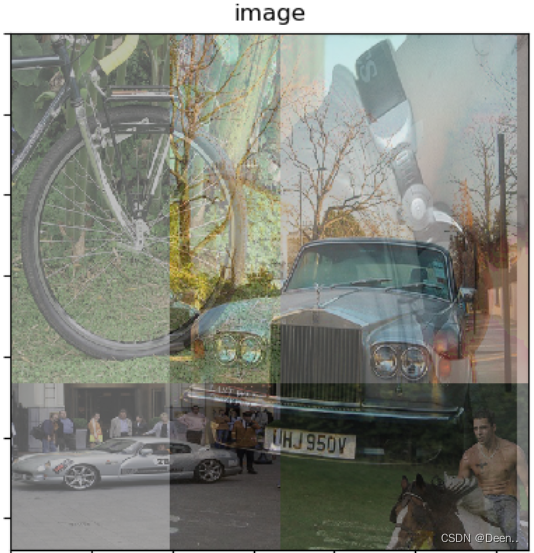
真实框调整
对真实框进行预处理,将真实框归一化,调整到0-1之间
,并且将真实框的格式从[x,y,x,y]调整[x,y,w,h]
nL = len(box)
labels_out = np.zeros((nL, 6))
if nL:
#---------------------------------------------------#
# 对真实框进行归一化,调整到0-1之间
#---------------------------------------------------#
box[:, [0, 2]] = box[:, [0, 2]] / self.input_shape[1]
box[:, [1, 3]] = box[:, [1, 3]] / self.input_shape[0]
#---------------------------------------------------#
# 序号为0、1的部分,为真实框的中心
# 序号为2、3的部分,为真实框的宽高
# 序号为4的部分,为真实框的种类
#---------------------------------------------------#
box[:, 2:4] = box[:, 2:4] - box[:, 0:2]
box[:, 0:2] = box[:, 0:2] + box[:, 2:4] / 2
真实框也调整为训练所需的格式[类别,坐标]
#---------------------------------------------------#
# 调整顺序,符合训练的格式
# labels_out中序号为0的部分在collect时处理
#---------------------------------------------------#
labels_out[:, 1] = box[:, -1]
labels_out[:, 2:] = box[:, :4]
labels_out的第一位用来登记这是这个真实框是这一批图片中的哪张图片的。
def yolo_dataset_collate(batch):
images = []
bboxes = []
for i, (img, box) in enumerate(batch):
images.append(img)
box[:, 0] = i
bboxes.append(box)
images = torch.from_numpy(np.array(images)).type(torch.FloatTensor)
bboxes = torch.from_numpy(np.concatenate(bboxes, 0)).type(torch.FloatTensor)
return images, bboxes
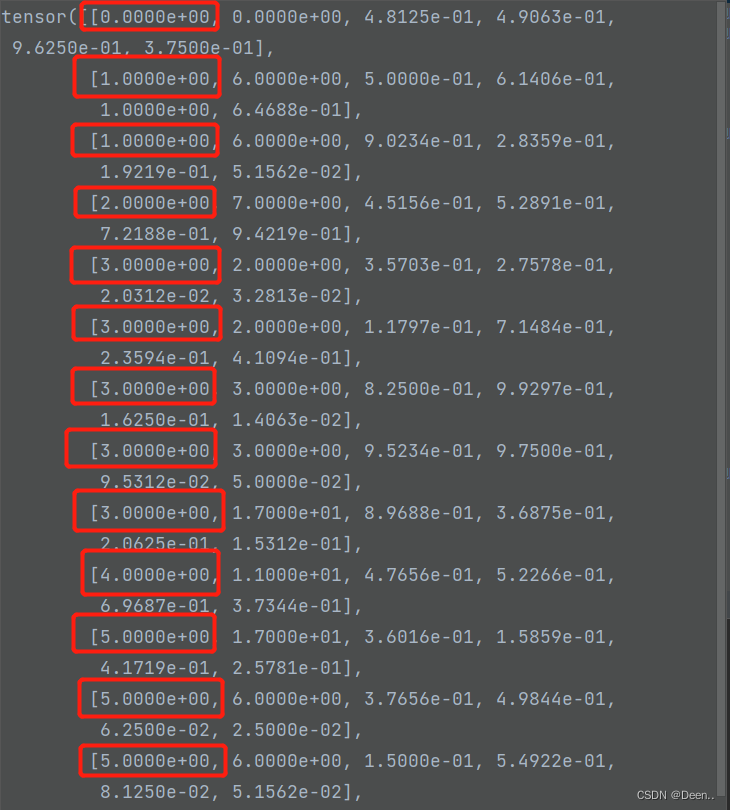
加载完毕后,将图片跟真是框取出,进行训练。
真实框格式【属于哪张图片,类别,坐标】
for iteration, batch in enumerate(gen):
if iteration >= epoch_step:
break
images, targets = batch[0], batch[1]
with torch.no_grad():
if cuda:
images = images.cuda(local_rank)
targets = targets.cuda(local_rank)
全部代码:
class YoloDataset(Dataset):
def __init__(self, annotation_lines, input_shape, num_classes, anchors, anchors_mask, epoch_length, \
mosaic, mixup, mosaic_prob, mixup_prob, train, special_aug_ratio = 0.7):
super(YoloDataset, self).__init__()
self.annotation_lines = annotation_lines
self.input_shape = input_shape
self.num_classes = num_classes
self.anchors = anchors
self.anchors_mask = anchors_mask
self.epoch_length = epoch_length
self.mosaic = mosaic
self.mosaic_prob = mosaic_prob
self.mixup = mixup
self.mixup_prob = mixup_prob
self.train = train
self.special_aug_ratio = special_aug_ratio
self.epoch_now = -1
self.length = len(self.annotation_lines)
self.bbox_attrs = 5 + num_classes
def __len__(self):
return self.length
def __getitem__(self, index):
index = index % self.length
#---------------------------------------------------#
# 训练时进行数据的随机增强
# 验证时不进行数据的随机增强
#---------------------------------------------------#
if self.mosaic and self.rand() < self.mosaic_prob and self.epoch_now < self.epoch_length * self.special_aug_ratio:
#DataFrame.sample方法主要是用来对DataFrame进行简单随机抽样的
lines = sample(self.annotation_lines, 3)
lines.append(self.annotation_lines[index])
shuffle(lines)
image, box = self.get_random_data_with_Mosaic(lines, self.input_shape)
if self.mixup and self.rand() < self.mixup_prob:
lines = sample(self.annotation_lines, 1)
image_2, box_2 = self.get_random_data(lines[0], self.input_shape, random = self.train)
image, box = self.get_random_data_with_MixUp(image, box, image_2, box_2)
else:
image, box = self.get_random_data(self.annotation_lines[index], self.input_shape, random = self.train)
image = np.transpose(preprocess_input(np.array(image, dtype=np.float32)), (2, 0, 1))
box = np.array(box, dtype=np.float32)
#---------------------------------------------------#
# 对真实框进行预处理
#---------------------------------------------------#
nL = len(box)
labels_out = np.zeros((nL, 6))
if nL:
#---------------------------------------------------#
# 对真实框进行归一化,调整到0-1之间
#---------------------------------------------------#
box[:, [0, 2]] = box[:, [0, 2]] / self.input_shape[1]
box[:, [1, 3]] = box[:, [1, 3]] / self.input_shape[0]
#---------------------------------------------------#
# 序号为0、1的部分,为真实框的中心
# 序号为2、3的部分,为真实框的宽高
# 序号为4的部分,为真实框的种类
#---------------------------------------------------#
box[:, 2:4] = box[:, 2:4] - box[:, 0:2]
box[:, 0:2] = box[:, 0:2] + box[:, 2:4] / 2
#---------------------------------------------------#
# 调整顺序,符合训练的格式
# labels_out中序号为0的部分在collect时处理
#---------------------------------------------------#
labels_out[:, 1] = box[:, -1]
labels_out[:, 2:] = box[:, :4]
return image, labels_out
def rand(self, a=0, b=1):
return np.random.rand()*(b-a) + a
def get_random_data(self, annotation_line, input_shape, jitter=.3, hue=.1, sat=0.7, val=0.4, random=True):
line = annotation_line.split()
#------------------------------#
# 读取图像并转换成RGB图像
#------------------------------#
image = Image.open(line[0])
image = cvtColor(image)
#------------------------------#
# 获得图像的高宽与目标高宽
#------------------------------#
iw, ih = image.size
h, w = input_shape
#------------------------------#
# 获得预测框
#------------------------------#
box = np.array([np.array(list(map(int,box.split(',')))) for box in line[1:]])
if not random:
scale = min(w/iw, h/ih)
nw = int(iw*scale)
nh = int(ih*scale)
dx = (w-nw)//2
dy = (h-nh)//2
#---------------------------------#
# 将图像多余的部分加上灰条
#---------------------------------#
image = image.resize((nw,nh), Image.BICUBIC)
new_image = Image.new('RGB', (w,h), (128,128,128))
new_image.paste(image, (dx, dy))
image_data = np.array(new_image, np.float32)
#---------------------------------#
# 对真实框进行调整
#---------------------------------#
if len(box)>0:
np.random.shuffle(box)
box[:, [0,2]] = box[:, [0,2]]*nw/iw + dx
box[:, [1,3]] = box[:, [1,3]]*nh/ih + dy
box[:, 0:2][box[:, 0:2]<0] = 0
box[:, 2][box[:, 2]>w] = w
box[:, 3][box[:, 3]>h] = h
box_w = box[:, 2] - box[:, 0]
box_h = box[:, 3] - box[:, 1]
box = box[np.logical_and(box_w>1, box_h>1)] # discard invalid box
return image_data, box
#------------------------------------------#
# 对图像进行缩放并且进行长和宽的扭曲
#------------------------------------------#
new_ar = iw/ih * self.rand(1-jitter,1+jitter) / self.rand(1-jitter,1+jitter)
scale = self.rand(.25, 2)
if new_ar < 1:
nh = int(scale*h)
nw = int(nh*new_ar)
else:
nw = int(scale*w)
nh = int(nw/new_ar)
image = image.resize((nw,nh), Image.BICUBIC)
#------------------------------------------#
# 将图像多余的部分加上灰条
#------------------------------------------#
dx = int(self.rand(0, w-nw))
dy = int(self.rand(0, h-nh))
new_image = Image.new('RGB', (w,h), (128,128,128))
new_image.paste(image, (dx, dy))
image = new_image
#------------------------------------------#
# 翻转图像
#------------------------------------------#
flip = self.rand()<.5
if flip: image = image.transpose(Image.FLIP_LEFT_RIGHT)
image_data = np.array(image, np.uint8)
#---------------------------------#
# 对图像进行色域变换
# 计算色域变换的参数
#---------------------------------#
r = np.random.uniform(-1, 1, 3) * [hue, sat, val] + 1
#---------------------------------#
# 将图像转到HSV上
#---------------------------------#
hue, sat, val = cv2.split(cv2.cvtColor(image_data, cv2.COLOR_RGB2HSV))
dtype = image_data.dtype
#---------------------------------#
# 应用变换
#---------------------------------#
x = np.arange(0, 256, dtype=r.dtype)
lut_hue = ((x * r[0]) % 180).astype(dtype)
lut_sat = np.clip(x * r[1], 0, 255).astype(dtype)
lut_val = np.clip(x * r[2], 0, 255).astype(dtype)
image_data = cv2.merge((cv2.LUT(hue, lut_hue), cv2.LUT(sat, lut_sat), cv2.LUT(val, lut_val)))
image_data = cv2.cvtColor(image_data, cv2.COLOR_HSV2RGB)
#---------------------------------#
# 对真实框进行调整
#---------------------------------#
if len(box)>0:
np.random.shuffle(box)
box[:, [0,2]] = box[:, [0,2]]*nw/iw + dx
box[:, [1,3]] = box[:, [1,3]]*nh/ih + dy
if flip: box[:, [0,2]] = w - box[:, [2,0]]
box[:, 0:2][box[:, 0:2]<0] = 0
box[:, 2][box[:, 2]>w] = w
box[:, 3][box[:, 3]>h] = h
box_w = box[:, 2] - box[:, 0]
box_h = box[:, 3] - box[:, 1]
box = box[np.logical_and(box_w>1, box_h>1)]
return image_data, box
def merge_bboxes(self, bboxes, cutx, cuty):
merge_bbox = []
for i in range(len(bboxes)):
for box in bboxes[i]:
tmp_box = []
x1, y1, x2, y2 = box[0], box[1], box[2], box[3]
if i == 0:
if y1 > cuty or x1 > cutx:
continue
if y2 >= cuty and y1 <= cuty:
y2 = cuty
if x2 >= cutx and x1 <= cutx:
x2 = cutx
if i == 1:
if y2 < cuty or x1 > cutx:
continue
if y2 >= cuty and y1 <= cuty:
y1 = cuty
if x2 >= cutx and x1 <= cutx:
x2 = cutx
if i == 2:
if y2 < cuty or x2 < cutx:
continue
if y2 >= cuty and y1 <= cuty:
y1 = cuty
if x2 >= cutx and x1 <= cutx:
x1 = cutx
if i == 3:
if y1 > cuty or x2 < cutx:
continue
if y2 >= cuty and y1 <= cuty:
y2 = cuty
if x2 >= cutx and x1 <= cutx:
x1 = cutx
tmp_box.append(x1)
tmp_box.append(y1)
tmp_box.append(x2)
tmp_box.append(y2)
tmp_box.append(box[-1])
merge_bbox.append(tmp_box)
return merge_bbox
def get_random_data_with_Mosaic(self, annotation_line, input_shape, jitter=0.3, hue=.1, sat=0.7, val=0.4):
h, w = input_shape
min_offset_x = self.rand(0.3, 0.7)
min_offset_y = self.rand(0.3, 0.7)
image_datas = []
box_datas = []
index = 0
for line in annotation_line:
#---------------------------------#
# 每一行进行分割
#---------------------------------#
line_content = line.split()
#---------------------------------#
# 打开图片
#---------------------------------#
image = Image.open(line_content[0])
image = cvtColor(image)
#---------------------------------#
# 图片的大小
#---------------------------------#
iw, ih = image.size
#---------------------------------#
# 保存框的位置
#---------------------------------#
box = np.array([np.array(list(map(int,box.split(',')))) for box in line_content[1:]])
#---------------------------------#
# 是否翻转图片
#---------------------------------#
flip = self.rand()<.5
if flip and len(box)>0:
image = image.transpose(Image.FLIP_LEFT_RIGHT)
box[:, [0,2]] = iw - box[:, [2,0]]
#------------------------------------------#
# 对图像进行缩放并且进行长和宽的扭曲
#------------------------------------------#
new_ar = iw/ih * self.rand(1-jitter,1+jitter) / self.rand(1-jitter,1+jitter)
scale = self.rand(.4, 1)
if new_ar < 1:
nh = int(scale*h)
nw = int(nh*new_ar)
else:
nw = int(scale*w)
nh = int(nw/new_ar)
image = image.resize((nw, nh), Image.BICUBIC)
#-----------------------------------------------#
# 将图片进行放置,分别对应四张分割图片的位置
#-----------------------------------------------#
if index == 0:
dx = int(w*min_offset_x) - nw
dy = int(h*min_offset_y) - nh
elif index == 1:
dx = int(w*min_offset_x) - nw
dy = int(h*min_offset_y)
elif index == 2:
dx = int(w*min_offset_x)
dy = int(h*min_offset_y)
elif index == 3:
dx = int(w*min_offset_x)
dy = int(h*min_offset_y) - nh
new_image = Image.new('RGB', (w,h), (128,128,128))
new_image.paste(image, (dx, dy))
image_data = np.array(new_image)
index = index + 1
box_data = []
#---------------------------------#
# 对box进行重新处理
#---------------------------------#
if len(box)>0:
np.random.shuffle(box)
box[:, [0,2]] = box[:, [0,2]]*nw/iw + dx
box[:, [1,3]] = box[:, [1,3]]*nh/ih + dy
box[:, 0:2][box[:, 0:2]<0] = 0
box[:, 2][box[:, 2]>w] = w
box[:, 3][box[:, 3]>h] = h
box_w = box[:, 2] - box[:, 0]
box_h = box[:, 3] - box[:, 1]
box = box[np.logical_and(box_w>1, box_h>1)]
box_data = np.zeros((len(box),5))
box_data[:len(box)] = box
image_datas.append(image_data)
box_datas.append(box_data)
#---------------------------------#
# 将图片分割,放在一起
#---------------------------------#
cutx = int(w * min_offset_x)
cuty = int(h * min_offset_y)
new_image = np.zeros([h, w, 3])
new_image[:cuty, :cutx, :] = image_datas[0][:cuty, :cutx, :]
new_image[cuty:, :cutx, :] = image_datas[1][cuty:, :cutx, :]
new_image[cuty:, cutx:, :] = image_datas[2][cuty:, cutx:, :]
new_image[:cuty, cutx:, :] = image_datas[3][:cuty, cutx:, :]
new_image = np.array(new_image, np.uint8)
#看mosiac的图片
# plt.figure("Image") # 图像窗口名称
# plt.imshow(new_image)
# plt.axis('on') # 关掉坐标轴为 off
# plt.title('image') # 图像题目
# plt.savefig(r'C:\Users\Administrator\Desktop\a.png')
# plt.close()
#---------------------------------#
# 对图像进行色域变换
# 计算色域变换的参数
#---------------------------------#
r = np.random.uniform(-1, 1, 3) * [hue, sat, val] + 1
#---------------------------------#
# 将图像转到HSV上
#---------------------------------#
hue, sat, val = cv2.split(cv2.cvtColor(new_image, cv2.COLOR_RGB2HSV))
dtype = new_image.dtype
#---------------------------------#
# 应用变换
#---------------------------------#
x = np.arange(0, 256, dtype=r.dtype)
lut_hue = ((x * r[0]) % 180).astype(dtype)
lut_sat = np.clip(x * r[1], 0, 255).astype(dtype)
lut_val = np.clip(x * r[2], 0, 255).astype(dtype)
new_image = cv2.merge((cv2.LUT(hue, lut_hue), cv2.LUT(sat, lut_sat), cv2.LUT(val, lut_val)))
new_image = cv2.cvtColor(new_image, cv2.COLOR_HSV2RGB)
#---------------------------------#
# 对框进行进一步的处理
#---------------------------------#
new_boxes = self.merge_bboxes(box_datas, cutx, cuty)
return new_image, new_boxes
def get_random_data_with_MixUp(self, image_1, box_1, image_2, box_2):
new_image = np.array(image_1, np.float32) * 0.5 + np.array(image_2, np.float32) * 0.5
if len(box_1) == 0:
new_boxes = box_2
elif len(box_2) == 0:
new_boxes = box_1
else:
new_boxes = np.concatenate([box_1, box_2], axis=0)
# 看图片
# plt.figure("Image") # 图像窗口名称
# plt.imshow(new_image.astype('uint8'))
# plt.axis('on') # 关掉坐标轴为 off
# plt.title('image') # 图像题目
# plt.savefig(r'C:\Users\Administrator\Desktop\b.png')
# plt.close()
return new_image, new_boxes
# DataLoader中collate_fn使用
def yolo_dataset_collate(batch):
images = []
bboxes = []
for i, (img, box) in enumerate(batch):
images.append(img)
box[:, 0] = i
bboxes.append(box)
images = torch.from_numpy(np.array(images)).type(torch.FloatTensor)
bboxes = torch.from_numpy(np.concatenate(bboxes, 0)).type(torch.FloatTensor)
return images, bboxes